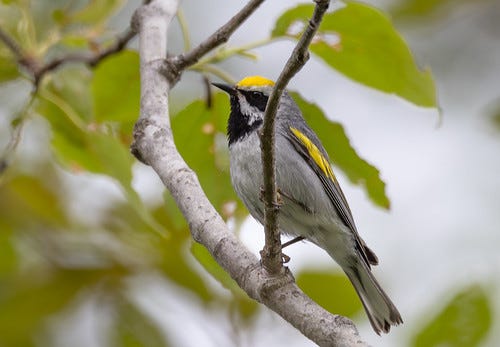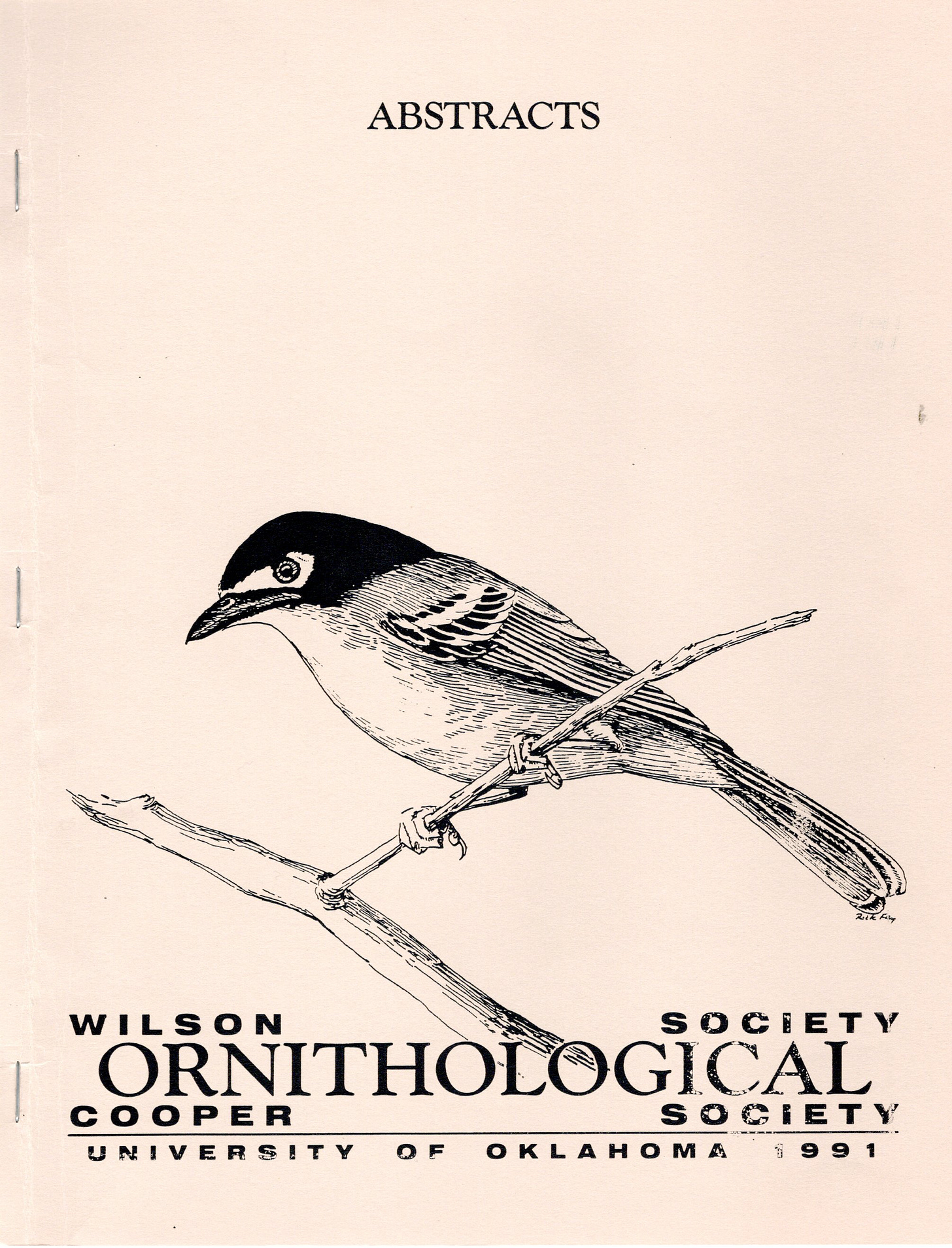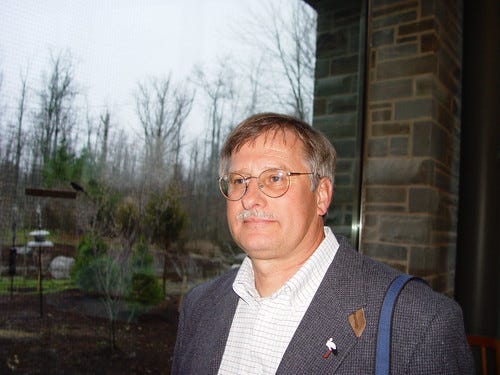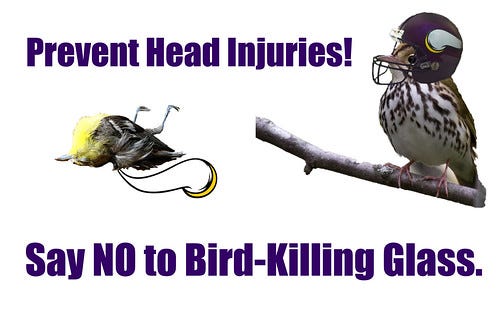Attending Professional Ornithological Meetings: Then and Now
Some things are much better. Some not so much...yet.
(Listen to the radio version of the first part of this here, and the second part here.)
I started out October in Estes Park, Colorado, attending the American Ornithological Society’s annual meeting—just the seventh time I’ve ever attended a major professional ornithologists’ meeting. In 1978, when what was then the American Ornithologists’ Union met in Madison, Wisconsin, I organized and led some of the field trips, helped the curator of the university zoology museum select and set out specimens for an open house for meeting participants, and contributed a silly poem, “Happy Traill’s to You, or Ornithologists Take Their Lumps and Split” to “The Auklet,” a parody of their journal, The Auk.
That was the meeting where I met my hero, Chandler Robbins, who went on one of my field trips and saved a seat for me at the banquet—one of the biggest thrills of my life.

At one paper session at that Madison meeting, a guy from Yale asked what institution I was associated with. When I answered that I taught at a nearby elementary school, he had the audacity to say, “Oh, you’re here to look at the pretty pictures.” I felt even more guilty than furious, as if my being “just” an elementary school teacher would somehow reinforce the idea held by too, too many male ornithologists at the time that women, or teachers, were not to be taken seriously. Somehow that encounter left a dark cloud over my memory of the entire meeting.
Because I was on the local organizing committee, my registration at the Madison meeting was free. Registration, lodging, and travel to most professional meetings is pricey, and not being affiliated with a professional institution, I’ve always paid all the costs myself, so it was thirteen years before I went to another meeting, this time a joint meeting of the Cooper and Wilson Ornithological Societies in Norman, Oklahoma, in 1991.
At that point I was no longer an elementary school teacher but a stay-at-home mommy, but somehow I mustered the courage to present a paper, “Daytime Warbler Migration in Fall along Lake Superior’s North Shore.” (I’m posting that paper today on Substack because it’s never been published in written form before.) That paper was given the Cooper Ornithological Society’s prestigious Frances F. Roberts Award, but apparently some ornithologists were upset that this honor could go to a stay-at-home mommy and changed the rule so that going forward, recipients had to be presenting work done as students. Again, both despite and because of the great honor, I ended up feeling like I didn’t really belong.
Nevertheless, I persisted, and the very next year, I attended the AOU meeting in Ames, Iowa. This time I had a mission—I was bound and determined to find an ornithologist who could help me solve a mystery about nighthawk digestion—a question I’d wondered about since I’d started rehabbing nighthawks a few years before. That’s how I found out about Gary Duke, a world authority on bird digestion, who took me on as his Ph.D. student on my ill-fated quest for a doctorate.
Other than questioning scientists about digestion, I went to that meeting intending to be just an observer, but when I sat in on the bird-calling contest, a shy older ornithologist asked me to come up with him because he’d always wanted to participate but was too nervous going up alone. So as long as I was standing up there anyway, I did some of my owl calls and ended up winning the contest in the repertoire category! On the strength of that, I started getting invitations to speak about owls at various birding festivals.
I didn’t attend another professional ornithologists’ meeting until 2005 and 2006, when I was writing a blog for a local optics company and attended the AOU meetings in Santa Barbara, California, and then Veracruz, Mexico. As usual I paid my own way but was earning enough income to cover my costs. In both cases, the pre- or post-convention field trips were a big reason I went, and both times I had a great time.
In 2012, when the Hawk Migration Association of North America met in Greenwich, Connecticut, I was asked to serve on a panel discussing environmental education focused on raptors. That was a fun meeting, and I was gobsmacked when at the end of the day they announced their annual awards, including one “for promoting conservation and environmental awareness through raptor outreach and education,” which they gave to me. I’m not a member and had no clue how any of them knew of my existence.
Since then, I’ve not gone to any professional meetings until the American Ornithological Society met this month. I scraped up the money to attend this meeting mostly because Christian Cooper was the keynote speaker and I badly wanted to meet him.
I also wanted to attend a major forum about the AOS plan to change eponymous bird names. Most of the opposition to this has been from older ornithologists, and since I’ve been a member for going on 50 years, I figured I should be there to provide at least a little diversity of opinion within the organization’s septuagenarians.
Attending this meeting was a much different experience than any of my previous professional meetings—way better in some ways, and not so much in a few other ways.
I was 26 years old when I attended the AOU meeting in Madison—much younger than the average attendee and with twice as many X chromosomes, though I matched the prevailing color. Things hadn’t changed much through the next few decades, but now, at the 2024 meeting, I was one of the very oldest attendees, and this time the people who attended looked much more like America, so a great many attendees weren’t white, straight, or male. Indeed, there is now a group called the “Rainbow Lorikeets” for LBGQTIA+ members and their allies.
Making ornithology more inclusive has been good not only for human beings—it’s had an amazing effect on the science of ornithology itself. What had been accepted as scientific truth for centuries—that males are the only birds who select and defend a territory, sing, and so many other important activities—was suddenly shown to be wrong thanks in large part to scientists questioning those old wives’ male ornithologists’ tales. And fresh new blood of all stripes has brought a refreshing focus on conservation to what had been, in many ways and again for centuries, a boy’s shoot ‘em up club.
Even as collecting specimens via shotgun became both less palatable to mainstream ornithologists and laden with legal constraints thanks to the Migratory Bird Act, for most of its history, many or even most scientists calling themselves ornithologists were prickly about equating any issues of bird mortality, especially regarding domestic cats and collisions with windows and other obstructions, with conservation. For the first few decades of my own career, mainstream conservation organizations such as Audubon and the American Bird Conservancy ignored or even pooh-poohed the importance of cats and window collisions, and scientists at the AOU itself rejected papers submitted to The Auk by Dr. Daniel Klem about window mortality, dismissing his work as “inconsequential” and “without significant conservation value.”
Many of the ornithologists when I was starting out had done a lot of scientific “collecting” themselves, some took advantage of birds killed at windows on campuses and in big cities to add to their scientific collections, and it was impossible for most of them to concede any value in individual bird life nor how losing enough individuals can add up to population losses.
Some scientists have explained to me that conservation issues are “emotional” and “political” while science is supposed to be entirely rational, as if the uses of scientific information aren’t at all emotional or political. Scientists also seem to focus on some unwritten law of scientific neutrality that really isn’t neutral at all. Ornithologists and even major conservation organizations have historically shied away from weighing in on controversial conservation issues while corporations don’t seem to have any trouble at all finding ornithologists in good standing to defend their side.
For the first two or three decades that Dan Klem was publishing his research about how dangerous windows are to birds leading up to his conclusion (way back in 1990!) that up to a billion birds are killed by windows every year in the United States, and for years after Sidney Gauthreaux published his radar data indicating that major migration movements of birds over the Gulf of Mexico had declined by 50 percent in just two decades, major conservationists were pooh-poohing those numbers.
At least one major conservation biologist dismissed my 2006 book, 101 Ways to Help Birds, because I’d used those numbers as I focused on issues such as cats, window glass and other obstructions, beef production, and early mowing—issues that weren’t yet acknowledged by those conservation biologists as significant problems. When those same naysayers independently came up with pretty much the exact same figures as Klem’s and Gauthreaux’s, they took all the credit for the “discovery” of how dire things really are.
At this 2024 meeting, I attended one AOS session pulling together representatives from various conservation groups. When I expressed how hard it was for individuals fighting serious but controversial conservation battles to get ornithologists onboard to help, I got no suggestions about how ornithologists with Ph.D.’s after their names might take a larger role in helping with these issues—just a patronizing “Thank you for your passion” before quickly moving on.
But with so much new blood in the American Ornithological Society and a greater focus on conservation, things are changing. I just hope it won’t be too little too late.














Dear Laura,
Thank you so much for this scoping, incisive view of professional ornithological meetings and the associated professional/social dynamics. I cringed at the thought that your contributions were ever dismissed because of your position as an elementary school teacher.
My degree is in Education, and I have my teaching certification for secondary school. I did my student teaching at my alma mater with my AP Biology teacher, Dr. Doris Litman. I credit Doris with helping me step onto the right path for me. When I balked at doing the required dissection of a fetal pig in our lab, she allowed me to do a report on something else, and I chose “Ecology.” I submitted my hand-written report to her, and she forgave the missed lab report. The research into the subject of ecology fanned the flame my interest in nature, and especially birds.
I am so glad you persevered in doing what you do and insisting on your right to be intellectually curious, despite the less than welcoming reception you got at some of those earlier meetings. We all belong wherever our interests may take us! I am so glad to know you, and I wish now I had come to the AOS meeting at Estes Park and gotten to hang out with you. ☺️
Chan (Dr. Robbins) was such a bird friend, people friend, and gentleman. After retirement we exchanged a few friendly emails comparing bird feeding note. I remember mailing a bread-and-butter letter to Dr. Alexander Skutch wishing him a happy 100th birthday before he passed, too. His response, though half unexpected, was a joyous moment in my life. Though them and people like Paul Ricklefs, Terry Root, Jim Brett, Jean-Marc Thiollay, Don Kroodsma, and Ian Newton were very gracious in their responses and are now long-retired, they will always have a profound influence and place in my heart. And yes, so glad for the Rainbow Lorikeets 🌈 Lorikeets, as I'm an out and devout cisgenger gay man.